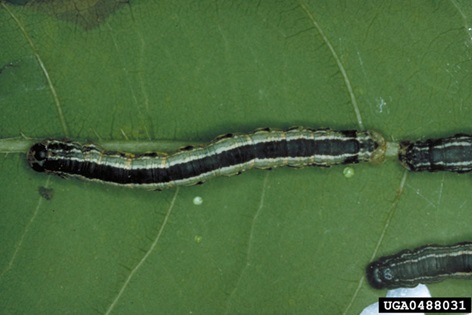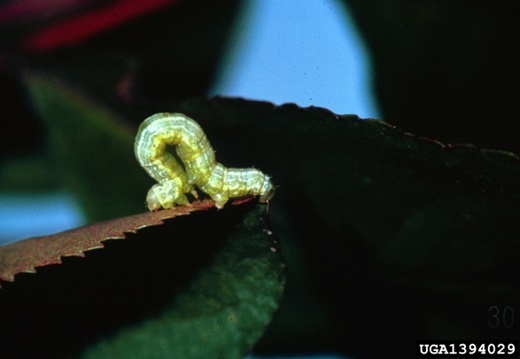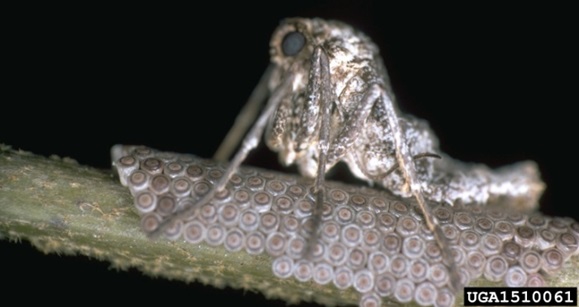Cankerworms
ENTFACT-401: Cankerworms | Download PDF
by Jonathan L. Larson, Extension Entomologist
University of Kentucky College of Agriculture
Fast Facts
- Both spring and fall cankerworms are inchworm pests of elms, oaks, maples, ash, and linden trees amongst others
- Both species can be variable in color as immatures and reach about an inch in length, spring cankerworms have 2 pairs of prolegs while fall cankerworms have 3.
- Caterpillars of both species are present at the start of the growing season, the common names refer to the times of year when the adult moths are active
- These caterpillars tend to be managed by natural forces but outbreaks have occurred in the past, should that happen Bt, spinosad, permethrin, bifenthrin, or cyfluthrin may be used to manage them
Potential Hosts
Spring and fall cankerworms feed on many different hosts but are most notable on elms, oaks, maples, ash, beech, hackberry, and linden trees.
Symptoms and Pest Description
Both species of cankerworms begin feeding at budbreak, initially causing small BB-sized holes in leaves between the veins. As the caterpillars grow, feeding damage also gets bigger, often congealing into holes that remove whole sections of green tissue. Leaves may look tattered or completely defoliated in outbreak years. Outbreaks of spring and fall cankerworms have occurred far less since the 1970’s, this coincides with the decline of elms (their preferred hosts) due to other issues.
As types of inchworms, both species are cylindrical caterpillars known for moving in a “looping” motion. Both reach about an inch in length before pupating. Spring cankerworms vary in color from light green, to brown, to black, though they almost always have two light stripes running the length of the body. Most importantly, they only have two pairs of prolegs on the rear end of the body. Fall cankerworms also vary in color, from light to dark green or black. Light colored individuals have two white lines on either side of the body, while darker colored individuals have a black stripe down the center of the back.
Both species may also be seen as an “annoyance” when they rappel from trees on lines of silken threads.

As adults, both species are “sexually dimorphic”, meaning that the males and females look considerably different. Males are brown and grey moths, with wings that are about an inch wide. Females on the other hand are wingless. They are still brown and grey but due to the lack of wings, they are sometimes referred to as “spider-like”.

Life Cycle in Kentucky
There is only generation of both these species per year in Kentucky. The common names of these pests refer to the period of time in which the adults are active, rather than when caterpillar damage may occur.
Spring cankerworms overwinter as pupae in the soil near host trees. The dimorphic adults emerge in the early spring, from February to March. The adult moths will mate, and eggs will be laid on host trees.
Conversely, fall cankerworms overwinter as eggs. Both species hatch from their eggs around budbreak and feeding/damage occurs in the same time period. Fall cankerworms will pupate in the summer and adults will emerge after the first hard freeze in the fall, mate and lay eggs.

Management
Control of spring or fall cankerworms tends to not be necessary. Natural forces, including predators and disease, usually keep them in check. As previously mentioned, issues with both have decreased since the 1970’s.
If an infestation is not noticed until damage is obvious and caterpillars are large and nearly ready to pupate, management will be difficult. This would especially be true of protecting large trees, which would require spraying higher into the canopy. Insecticides that might provide management would include bifenthrin, cyfluthrin, malathion, and permethrin.
Alternatively, there are options for preventive control if issues have been consistent. If caterpillars of either species are detected in the spring and they are still under ½ inch long, Bacillus thuringiensis (more commonly known as Bt) can be applied to young leaves. Spinosad would be another option. These are both organic. Trees could also be injected with systemic products such as acephate or abamectin in the spring.
Revised: 1/25
CAUTION! Pesticide recommendations in this publication are registered for use in Kentucky, USA ONLY! The use of some products may not be legal in your state or country. Please check with your local county agent or regulatory official before using any pesticide mentioned in this publication.
Of course, ALWAYS READ AND FOLLOW LABEL DIRECTIONS FOR SAFE USE OF ANY PESTICIDE!
Images: University of Kentucky Entomology.
